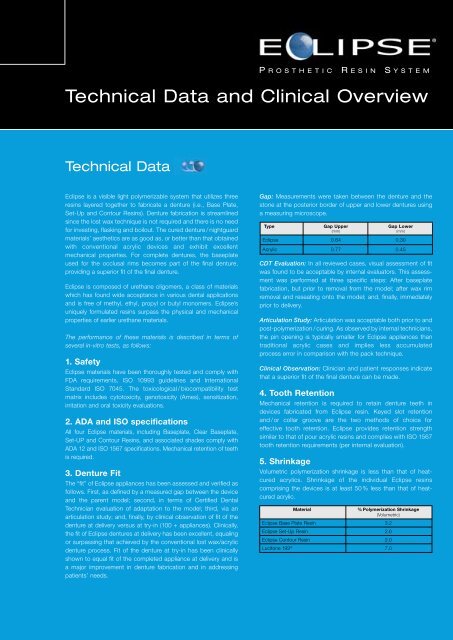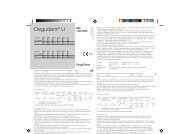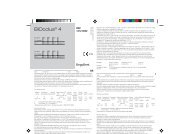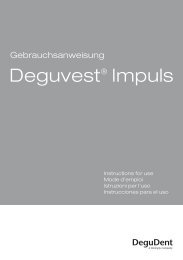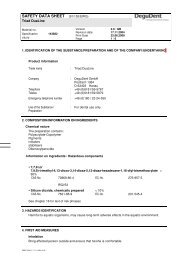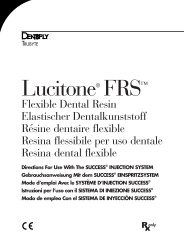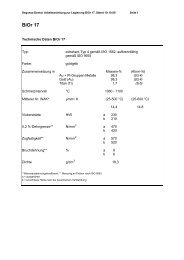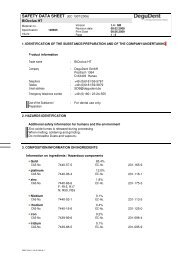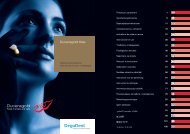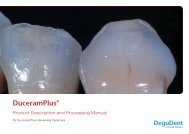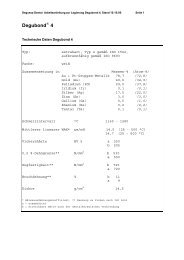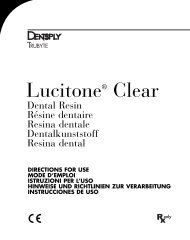Eclipse technical datasheet GB - DeguDent
Eclipse technical datasheet GB - DeguDent
Eclipse technical datasheet GB - DeguDent
You also want an ePaper? Increase the reach of your titles
YUMPU automatically turns print PDFs into web optimized ePapers that Google loves.
P ROSTHETIC R ESIN S YSTEMTechnical Data and Clinical OverviewTechnical Data<strong>Eclipse</strong> is a visible light polymerizable system that utilizes threeresins layered together to fabricate a denture (i.e., Base Plate,Set-Up and Contour Resins). Denture fabrication is streamlinedsince the lost wax technique is not required and there is no needfor investing, flasking and boilout. The cured denture / nightguardmaterials’ aesthetics are as good as, or better than that obtainedwith conventional acrylic devices and exhibit excellentmechanical properties. For complete dentures, the baseplateused for the occlusal rims becomes part of the final denture,providing a superior fit of the final denture.<strong>Eclipse</strong> is composed of urethane oligomers, a class of materialswhich has found wide acceptance in various dental applicationsand is free of methyl, ethyl, propyl or butyl monomers. <strong>Eclipse</strong>’suniquely formulated resins surpass the physical and mechanicalproperties of earlier urethane materials.The performance of these materials is described in terms ofseveral in-vitro tests, as follows:1. Safety<strong>Eclipse</strong> materials have been thoroughly tested and comply withFDA requirements, ISO 10993 guidelines and InternationalStandard ISO 7045. The toxicological / biocompatibility testmatrix includes cytotoxicity, genotoxicity (Ames), sensitization,irritation and oral toxicity evaluations.2. ADA and ISO specificationsAll four <strong>Eclipse</strong> materials, including Baseplate, Clear Baseplate,Set-UP and Contour Resins, and associated shades comply withADA 12 and ISO 1567 specifications. Mechanical retention of teethis required.3. Denture FitThe “fit” of <strong>Eclipse</strong> appliances has been assessed and verified asfollows. First, as defined by a measured gap between the deviceand the parent model; second, in terms of Certified DentalTechnician evaluation of adaptation to the model; third, via anarticulation study; and, finally, by clinical observation of fit of thedenture at delivery versus at try-in (100 + appliances). Clinically,the fit of <strong>Eclipse</strong> dentures at delivery has been excellent, equalingor surpassing that achieved by the conventional lost wax/acrylicdenture process. Fit of the denture at try-in has been clinicallyshown to equal fit of the completed appliance at delivery and isa major improvement in denture fabrication and in addressingpatients’ needs.Gap: Measurements were taken between the denture and thestone at the posterior border of upper and lower dentures usinga measuring microscope.Type Gap Upper Gap Lower(mm)(mm)<strong>Eclipse</strong> 0.64 0.30Acrylic 0.77 0.45CDT Evaluation: In all reviewed cases, visual assessment of fitwas found to be acceptable by internal evaluators. This assessmentwas performed at three specific steps: After baseplatefabrication, but prior to removal from the model; after wax rimremoval and reseating onto the model; and, finally, immediatelyprior to delivery.Articulation Study: Articulation was acceptable both prior to andpost-polymerization / curing. As observed by internal technicians,the pin opening is typically smaller for <strong>Eclipse</strong> appliances thantraditional acrylic cases and implies less accumulatedprocess error in comparison with the pack technique.Clinical Observation: Clinician and patient responses indicatethat a superior fit of the final denture can be made.4. Tooth RetentionMechanical retention is required to retain denture teeth indevices fabricated from <strong>Eclipse</strong> resin. Keyed slot retentionand /or collar groove are the two methods of choice foreffective tooth retention. <strong>Eclipse</strong> provides retention strengthsimilar to that of pour acrylic resins and complies with ISO 1567tooth retention requirements (per internal evaluation).5. ShrinkageVolumetric polymerization shrinkage is less than that of heatcuredacrylics. Shrinkage of the individual <strong>Eclipse</strong> resinscomprising the devices is at least 50 % less than that of heatcuredacrylic.Material% Polymerization Shrinkage(Volumetric)<strong>Eclipse</strong> Base Plate Resin 3.2<strong>Eclipse</strong> Set-Up Resin 2.6<strong>Eclipse</strong> Contour Resin 2.0Lucitone 199 ® 7.0
Technical Data and Clinical Overview6. Flexural Properties<strong>Eclipse</strong> resins and the layered materials provide excellentflexural properties compared to commercially available andclinically effective materials. These findings have been confirmedby independent laboratory testing.Flexural Strength of <strong>Eclipse</strong> vs. conventional AcrylicsMaterial Flexural Strength Flexural ModulusMPaGPa<strong>Eclipse</strong> Clear Base Plate Resin 123 3.3<strong>Eclipse</strong> Base Plate Resin 125 3.2<strong>Eclipse</strong> Set-Up Resin 123 3.1<strong>Eclipse</strong> Contour Resin 113 2.9Lucitone 199 ® 95 2.8Selectaplus 63 2.4Selectaplus H 74 2.67. Impact Strength<strong>Eclipse</strong> resins by themselves, as well as layered <strong>Eclipse</strong> resins,provide excellent impact properties compared to commerciallyavailable, clinically effective acrylic materials. These findingshave been confirmed by independent laboratory testing.Impact Strength of <strong>Eclipse</strong> vs. AcrylicsMaterial8. Appliance DesignUn-notched impact strengthkJ/m 2<strong>Eclipse</strong> Clear Resin 16.8<strong>Eclipse</strong> Base Plate Resin 14.7<strong>Eclipse</strong> Set-Up Resin 11.3<strong>Eclipse</strong> Contour Resin 7.3<strong>Eclipse</strong> Base Plate-Base Plate 16.3<strong>Eclipse</strong> Base Plate-Contour 9.6Lucitone 199 ® 9.8Selectaplus 1.9Selectaplus H 2.3An <strong>Eclipse</strong> appliance is essentially comprised of a layering ofthree materials: Base Plate, Set-Up and Contour Resin. Asmight be expected, the interface between the respectivematerials is critical in determining performance of a deviceconstructed in this manner. Flexural properties of layeredtest specimens are consistent with the properties of thecomponent materials and compare favorably with commondental resins. Moreover, extended hydrolytic testing (immersionin water) at elevated temperatures indicates that the layeredmaterials are stable, with no indication of delamination priorto or after destructive testing. Repairs are similarly stable andeffective.Flexural Properties – Layered <strong>Eclipse</strong>Material Combination Flexural Deflection FlexuralStrengthModulusMPa mm GPa<strong>Eclipse</strong> Base Plate/Contour 123 9.4 3.3<strong>Eclipse</strong> Base Plate/Base Plate 125 9.1 3.29. Hydrolytic StabilityHydrolytic testing shows that the flexural properties of <strong>Eclipse</strong>resins are effectively maintained upon extended periods ofimmersion in water at elevated temperatures.Flexural Properties of Hydrated <strong>Eclipse</strong>Material Water Flexural Deflection FlexuralImmersion Strength ModulusPeriod MPa mm GPa<strong>Eclipse</strong>Baseline 120 9.1 3.2Base Plate ResinHydrated for 132 9.4 3.3<strong>Eclipse</strong>15 mths at 37°Baseline 118 8.9 3.0Contour ResinHydrated for 125 9.1 3.215 mths at 37°Lucitone 199 ® Baseline 97 9.7 2.9Hydrated for 99 9.7 2.915 mths at 37°Flexural Properties of Layered Hydrated <strong>Eclipse</strong> RepairsMaterial Water Flexural Deflection FlexuralImmersion Strength ModulusPeriod MPa mm GPaBase Plate/Contour Baseline 123 9.4 3.3Hydrated for 130 9.1 3.312 mths at 37°Base Plate/Base Plate Baseline 125 9.1 3.2Hydrated for 139 9.1 3.412 mths at 37°Flexural Properties of Hydrated <strong>Eclipse</strong> RepairsMaterial Water Flexural Deflection FlexuralImmersion Strength ModulusPeriod MPa mm GPaBase Plate/ Baseline 117 9.7 3.1Base Plate RepairHydrated for 131 8.6 3.46 mths at 37°
10. Color StabilityAll four <strong>Eclipse</strong> materials, including Base Plate, Clear Base Plate,Set-Up and Contour Resins, comply with the UV color stabilityrequirements of the ADA 12 and ISO 1567 standards. <strong>Eclipse</strong>shade variants are also color stable.11. Stain ResistanceThe <strong>Eclipse</strong> chemistry is inherently resistant to common stainingchromophores that are consumed during eating and drinking.Good stain resistance was demonstrated with two commonstaining agents, coffee and mustard, in an internal acceleratedin-vitro stain test when appliances were properly polished. It isimportant to achieve a smooth surface when polishing theappliances since rough, unpolished areas may show slight stain,similar to conventional denture base materials.In-vitro mustard stain resistance is similar to Lucitone 199denture base material. Dentures, repairs and relines all showacceptable stain resistance.12. Plaque ResistanceSome <strong>Eclipse</strong> clinical case reviews from the clinical study haveshown that plaque growth on devices appears to be equal to orbetter than that of a typical acrylic appliance.13. Working Time<strong>Eclipse</strong> materials are designed to be light polymerized in aprocessing unit developed for this purpose. Accordingly, thesematerials are also sensitive to ambient light but have a minimum“working time” of 60 minutes under typical room illumination.You must avoid exposing <strong>Eclipse</strong> materials to direct sunlight priorto processing.14. Shelf LifeAll uncured <strong>Eclipse</strong> resins have a shelf life of two years whenstored at room temperature in light-safe conditions away fromdirect sunlight.Clinical OverviewA multi-site clinical study was conducted to assess fit, function,color stability, tissue compatibility, and overall patient acceptanceof <strong>Eclipse</strong> dentures, removable partial dentures and occlusalsplints.This study evaluated complete dentures, partial dentures, andocclusal splints in 145 patients as of August 2002, with somerestorations/appliances now over two years old. Thisinvestigation evaluated <strong>Eclipse</strong> appliances for fit, soft tissuecompatibility, resistance to breakage, tooth retention, as well aspatient acceptance, including aesthetic, feel, taste and hygieneperceptions.Data CollectedThe following data were collected for Full Dentures:• Tissue inflammation (DePaola Index)• Denture base fit and stability at try-in, insertion and recalls(modified Kapur Index)• Ease of tooth position adjustment (if needed)• Tissue reaction to unprocessed denture base material• Color stability at recalls• Evidence of allergical reaction at recalls• Other observations (debonds, textural changes, etc.)The following data were collected for Partial Dentures:• Tissue inflammation (DePaola Index)• Ease of tooth position adjustment (if needed)• Tissue reaction to unprocessed denture base material• Color stability at recalls• Evidence of allergical reaction at recalls• Other observations (debonds, textural changes, etc.)
64037/0507/DMRFor full and partial dentures, patients were asked about taste andodour from the appliance at try-in and at recalls.Additonally, they were asked about:• Overall satisfaction with the appliance• Ease of maintenance (cleaning)• Aesthetics• Overall acceptabilityFor occlusal splints, the following data were collected:• Incidence of breakage• Color stability• Evidence of excessive wear• Taste• OdourIn ConclusionWe believe that <strong>Eclipse</strong> is a breakthrough in prosthetic resintechnology. It is essentialy a material that handles like wax andpolymerizies to the standards of a conventional denture basematerial. Based on initial observations from our multi-site clinicalstudy, with some patients having worn their <strong>Eclipse</strong> dentures forwell over two years, we are confident that an <strong>Eclipse</strong> processedbaseplate offers a superior fitting denture.*<strong>Eclipse</strong> is a clear advantage over conventional dentures becausenow problems with fit can be caught early in the treatmentprocess.* Monitoring of clinical cases will continue through two-year patient recalls.Summary of Findings:The truly remarkable results of this continuing clinical studysubstantiate the clinical claims that a superior fitting denture canbe made and that elimination of methylmethacrylate monomerresults in a non-irritating, functional, aesthetic, durable, hygienicprosthesis without objectionable taste or odour.• No evidence of any allergic reaction has been noted.• The material appears kind of the mucosal tissues.• Reaction of the tissue to the uncured materials is benign.• Denture base fit as assessed with the Modified KapurIndex is excellent.• Few changes were observed between try-in, insertion andrecall visits.• The processed baseplate yields exceptional stability andretention at try-in, accurately predicting fit and stability atinsertion.• The denture base material is color-stable.• Occlusal splints are successful.Manufacturer:DENTSPLY Intern. Inc.York, PA 17405 – 0872 U.S.A.EU Representative:<strong>DeguDent</strong> GmbHP. O. Box 13 64 · 63403 HanauGERMANYwww.dentsply-degudent.com


